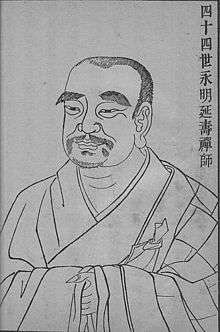Yongming Yanshou
| Yongming Yanshou 永明延壽 | |
|---|---|
 | |
| School | Chán |
| Personal | |
| Born |
904 Hangzhou or Yuhang |
| Died | 975 (aged 72) |
| Senior posting | |
| Title | Chán master |
| Predecessor | Tiantai Deshao |
| Religious career | |
| Teacher | Tiantai Deshao |
| Part of a series on |
| Zen Buddhism |
|---|
 |
|
Persons Chán in China
Zen in Japan Seon in Korea Zen in the USA Category: Zen Buddhists |
|
Awakening |
|
Practice |
|
Related schools |
Yongming Yanshou (Chinese: 永明延壽; Wade–Giles: Yung-ming Yen-shou; Japanese: 永明延寿 or Yōmyō Enju; Korean: Yǒngmyǒng Yǒnsu; Vietnamese: Vĩnh Minh Diên Thọ) (904–975) was a prominent Buddhist monk during the Five Dynasties and Ten Kingdoms period and early Song Dynasty in China.
Biography
Yongming Yanshou is first mentioned in biographical form by Zanning (贊寧) in a work called the Song Biographies of Eminent Monks (Chinese: 宋高僧傳; pinyin: song gaoseng zhuan), which was produced in 988, 12 years after Yanshou's death.[1][2]
Yanshou lived largely during the Five Dynasties and Ten Kingdoms period, in the independent Wuyue kingdom. This age was characterized by nearly continuous warfare and political disorder. The future of Buddhism was especially uncertain during this time due to widespread suppression and sponsored destruction of temples. However, most of this activity took place in the north of China, while Yanshou resided in the independent Wuyue kingdom of the south, which was relatively stable during this time. Furthermore, unlike the trouble Buddhism faced in the north, the ruling Qian family heavily patronized Buddhist and other religious institutions.
He was born in either the capital city of Wuyue, modern-day Hangzhou, or a suburb of it, Yuhang, in the year 904. He would have served as an official before becoming a monk, although the exact nature of the position is disagreed upon in biographical sources. He probably became a monk around 932 under the Zen teacher Ts'ui Yen. At some point he left his initial teacher and went to Mount Tiantai, where his attainment was confirmed by the teacher Tiantai Dehshao. Around 952 he again moved, this time to Mount Xuědòu (雪窦山), where he served as a teacher and apparently attracted many students. He is said to have practiced seated chanting and silent meditation.
In 960, the King of Wuyue, Qian Chu, assigned Yanshou to be the abbot of Lingyin Temple, which the king had recently re-established. Only a year later in 961, the king relocated Yanshou to the newly constructed Yongming Temple, from which he would take his name. Here Yanshou is said to have become very prominent. He received gifts from the King of Korea, Gwangjong of Goryeo, and in return he ordained 36 Korean monks, who then returned home to teach. In 974 he returned to Mount Tiantai, and the following year he died.[2]
Teachings and influence
Yongming Yanshou is best known for attempting to synthesize the diverse and seemingly contradictory teachings of the various schools of Buddhism that existed in China. He is often associated with Pure Land Buddhism and Zen, but Pure Land largely formed after his lifetime, and he is largely concerned with Tiantai in his writings.
Because he held views that conflicted with the Rinzai tradition, which came to be the dominant school of Japanese Zen, he has been criticized or marginalized in many later accounts of Zen history. As a result of this, he was largely ignored by Western scholars of Chan in the 20th century, most of whom worked from a Japanese perspective. Nonetheless, recent Western scholarship recognizes his importance, and he has been an enduring influential figure in the eyes of Chinese, Korean, and Vietnamese branches of Zen, and he is deeply revered in the Pure Land school.[3]
References
- ↑ Welter, Albert (2011), Yongming Yanshou's Conception of Chan in the Zongjing Lu: A Special Transmission Within the Scriptures, Oxford University Press, ISBN 978-0-19-976031-2
- 1 2 Welter, Albert (1992), The Meaning of Myriad Good Deeds: A Study of Yung-ming Yen-shou and the Wan-shan t'ung-kuei chi, P. Lang, ISBN 978-0-8204-1796-7
- ↑ Welter, Albert (2010), "Yongming Yanshou: Scholastic as Chan Master", in Steven Heine; Dale Wright, Zen Masters, Oxford University Press, pp. 59–89, ISBN 978-0-19-536764-5